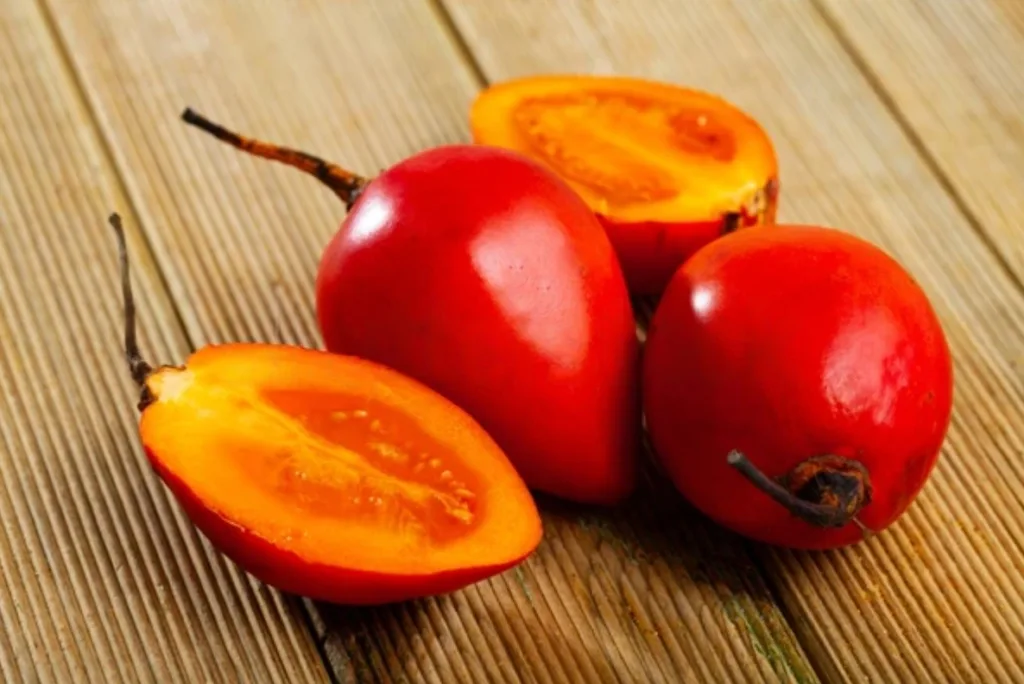Introduction
Tamarillo, also known as the tree tomato, is a small, tangy fruit that has been gaining popularity due to its unique flavor and numerous health benefits. Originating from South America, particularly the Andes region, tamarillo is now cultivated in various parts of the world, including New Zealand, Australia, and Southeast Asia. This article delves into the various health benefits and uses of tamarillo, highlighting why it should be a staple in your diet.
Nutritional Profile of Tamarillo
Tamarillo is a bootstrapper of essential nutrients, making it a valuable addition to a balanced diet. A quick overview of its nutritional composition is as follows:
- Vitamins:
- Vitamin A: A crucial vitamin for maintaining healthy vision and skin.
- Vitamin C: Improves the immune system and helps in collagen production.
- Vitamin E: Protects cells from oxidative damage.
- Minerals:
- Potassium: essential for heart health and blood pressure regulation.
- Iron: Important for red blood cell production and preventing anemia.
- Magnesium: Supports muscle and nerve function.
- Phosphorus: Necessary for healthy bones and teeth.
- Antioxidants:
- Anthocyanins: Combat free radicals and reduce inflammation.
- Flavonoids: Provide various health benefits, including heart health support.
- Fiber:
- Dietary Fiber: Promotes digestion and supports gut health.

Health Benefits of Tamarillo
1. Boosts Immunity
Tamarillo is an excellent source of vitamin C, a potent antioxidant known for its immune-boosting properties. Regular consumption of tamarillo can help strengthen the immune system, making the body more resilient against infections and illnesses. Vitamin C stimulates the production of white blood cells, which are essential for fighting off pathogens. Additionally, it enhances the skin’s defense system, acting as a first line of defense against external threats.
2. Promotes Heart Health
The high potassium content in tamarillo helps regulate blood pressure levels by counteracting the effects of sodium. This balance is essential for maintaining healthy blood pressure and reducing the risk of hypertension. Furthermore, the antioxidants in tamarillo, such as anthocyanins and flavonoids, help reduce the oxidation of LDL cholesterol, preventing plaque buildup in the arteries. This reduces the risk of atherosclerosis, heart attacks, and strokes.
3. Enhances Vision
Rich in vitamin A, tamarillo is beneficial for maintaining good vision. Vitamin A is a crucial component of rhodopsin, a protein in the eyes that absorbs light and supports night vision. Adequate vitamin A intake helps prevent night blindness and reduces the risk of age-related macular degeneration, a leading cause of vision loss in older adults.
4. Aids in Weight Management
Tamarillo is low in calories and high in fiber, making it an ideal fruit for those looking to manage their weight. The fiber content promotes a feeling of fullness, reducing overall calorie intake and aiding in weight loss. Additionally, the fruit’s low glycemic index helps regulate blood sugar levels, preventing spikes and crashes that can lead to overeating.
5. Improves Skin Health
The vitamins and antioxidants in tamarillo contribute to healthy, glowing skin. Vitamin C aids in collagen production, which is essential for skin elasticity and firmness. Collagen is a protein that helps maintain the skin’s structure, reducing the appearance of fine lines and wrinkles. Vitamin E, another antioxidant in tamarillo, protects the skin from UV damage and premature aging by neutralizing free radicals.
6. Supports Digestive Health
The dietary fiber in tamarillo promotes regular bowel movements and prevents constipation. Fiber adds bulk to the stool, making it easier to pass and reducing the risk of digestive issues such as irritable bowel syndrome (IBS) and diverticulosis. Additionally, fiber supports the growth of beneficial gut bacteria, enhancing overall digestive health and improving nutrient absorption.
7. Reduces Inflammation
Tamarillo contains anti-inflammatory compounds that help reduce inflammation in the body. Chronic inflammation is linked to various health conditions, including arthritis, heart disease, and certain cancers. The antioxidants in tamarillo, particularly anthocyanins, help reduce the production of pro-inflammatory cytokines, thereby alleviating symptoms of inflammatory diseases and promoting overall health.
8. Enhances Metabolism
The vitamins and minerals in tamarillo play a crucial role in metabolic processes. Vitamin B6, present in tamarillo, is essential for the metabolism of proteins, fats, and carbohydrates. It helps convert food into energy, supporting overall metabolic health and ensuring that the body functions efficiently.
9. Supports Bone Health
Tamarillo contains calcium and phosphorus, both of which are essential for maintaining strong and healthy bones. Calcium is vital for bone density, while phosphorus supports the formation of bone and teeth. Regular consumption of tamarillo can help reduce the risk of osteoporosis and other bone-related disorders.
10. Enhances Cognitive Function
The antioxidants and vitamins in tamarillo contribute to brain health. Vitamin C and E protect brain cells from oxidative stress, reducing the risk of neurodegenerative diseases such as Alzheimer’s and Parkinson’s. Additionally, the fruit’s anti-inflammatory properties help maintain cognitive function and improve memory and concentration.

Culinary Uses of Tamarillo
Tamarillo’s unique flavor, a blend of sweet and tangy, makes it a versatile ingredient in various culinary applications. Here are some popular ways to incorporate tamarillo into your diet:
1. Fresh Consumption
The simplest way to enjoy tamarillo is to eat it fresh. Slice the fruit in half and scoop out the flesh with a spoon. You can sprinkle a little sugar or salt to enhance the flavor.
2. Smoothies and Juices
Tamarillo can be blended into smoothies or juices for a nutritious and refreshing drink. Combine it with other fruits like bananas, berries, or oranges to create a delicious and healthy beverage.
3. Salads
Add tamarillo to salads for a burst of flavor and color. It pairs well with leafy greens, avocados, and nuts. You can also use tamarillo in fruit salads along with apples, kiwis, and grapes.
4. Sauces and Chutneys
Tamarillo can be used to make tangy sauces and chutneys that complement various dishes. These can be served with meats, fish, or as a dip for snacks.
5. Desserts
Tamarillo can be used in desserts like tarts, pies, and crumbles. Its tangy flavor balances the sweetness of these treats, adding a unique twist.

How to Select and Store Tamarillo
When choosing tamarillos, look for fruits that are firm and have a smooth, unblemished skin. The color can vary from red to orange, depending on the variety. Avoid fruits that are overly soft or have visible signs of damage.
Store tamarillos at room temperature if you plan to consume them within a few days. For longer storage, keep them in the refrigerator. Ripe tamarillos can also be frozen for future use.
Conclusion
Tamarillo is a nutritious and versatile fruit that offers numerous health benefits. From boosting immunity and promoting heart health to enhancing vision and improving skin health, tamarillo can significantly contribute to overall well-being. Its unique flavor makes it a delightful addition to various dishes, from salads and smoothies to sauces and desserts. Incorporate tamarillo into your diet today and reap the myriad benefits this superfruit has to offer.
Final Thoughts
Whether you are looking to improve your health or simply want to explore new flavors, tamarillo is an excellent choice. Its rich nutritional profile and versatile culinary uses make it a valuable addition to any diet. Start incorporating tamarillo into your meals and experience the myriad benefits of this unique fruit.
By understanding and utilizing the health benefits and uses of tamarillo, you can make informed choices that support your health and culinary adventures.
Topics covered
- What is Tamarillo?
- What are key nutrients of Tamarillo?
- What are health benefits of Tamarillo?
- What are uses of Tamarillo?
- What is Tamarillo good for?
- How to select and store Tamarillo?








2 thoughts on “The Health Benefits and Uses of Tamarillo: A Comprehensive Guide”